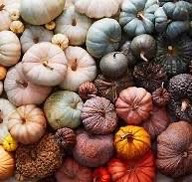Sunday, June 22, 2025
Now is the time to plant pumpkin seeds! Pumpkins love the hot weather.
Pumpkins are part of the squash family. Squash originated in Mexico. There are cave drawings from 8000 to 6500 BC depicting squash and the oldest remains found are from 8750 BC. Squash was grown extensively by Native Americans as part of the “Three Sisters”-squash, corn and beans. These three support each other's growth. Beans provide nitrogen to the corn and squash. The corn provides the stalks for the beans to grow up on. The sprawling squash vines crowd out any weeds.
Pumpkins love organic matter. If you throw a few seeds in your compost pile, you will be rewarded with exuberant vines.
Plant squash when soil temperatures are 70F for optimal germination. Usually end of May through beginning of June are the best time to plant pumpkin but our weather has been so cool that the pumpkin seeds didn't germinate. I have resown them this last week.
Add a fertilizer rich in phosphorous a week after transplanting, when flowers first appear and again when fruits begin to form. They love water, too. If growing in a pot, keep well watered and don’t let dry out.
Don’t panic when the first blooms fall off without producing any fruits. There are male and female flowers. If yours falls off, it was likely a poor guy that withered without the love a gal. There can also be some false starts with malformed fruits. Don’t worry, the plant will put on more blooms and you will be on your way to baby pumpkins before you know it! Each vine does not produce many fruits. It is typical to get 2-3 pumpkins off a single vine.
Pumpkins you typically leave on the vine until the vine dies and the fruit loses its sheen in the fall. Then bring inside and store in a cool, not cold, dark place.
The two biggest pest problems are squash bugs (left) and squash vine borer (below left are eggs and right is the adult). Inspect the plant for squash bugs. You can wear gloves, pick them off and throw them in a bowl of soapy water.
Natural, organic pest strategies and how to make your own bug spraysThe squash vine borer is best thwarted by planting early or late. They fly in mid-June. If planting early, be sure to inspect regularly the stems for any eggs. Scrap off any that you find. When the eggs hatch, the catepillar will dig into the vine and eat its way through its length. You will have a strong plant one day and a wilted on the next. You can wrap the stem base as a preventative. The good news is that your plant does get infested, you can replace with another one. They grow quickly in warm temperatures and soils of summer.

The cucumber beetle can infect the plant with a bacterial disease called wilt or cucumber mosaic virus. The cucumber beetles we get here look like yellow/green lady bugs (left). There are also striped varieties (below).

In late summer in areas with high humidity, you can get powdery mildew. This can be treated by spraying with baking soda, copper, fresh whey and other organic fungal sprays and soil drenches. When watering be sure to not get the foliage wet and water in the morning so any extra is quickly evaporated.
If you bought a heirloom or open pollinated variety from the store or farmers market, you can easily save the seed to grow next year's plants. From your best plant with no disease, let one get large, remove from the vine and leave it out in the garden bed. The inner flesh will deteriorate leaving the seeds. Just scoop out the seeds, put in a plastic baggie, date and keep in the frig for next year. You can also scoop out the seeds from the fruit right off the vine and leave the seeds indoors to dry on a paper towel or plate. Seed saving-fun, easy and a cost saver
If there is a variety that you love the looks and/or taste of from the store or farmers market, save the seeds and grow some of your own next year! If it is an heirloom, it will come back "true" to the parent. If it is a hybrid, it may be a surprise squash. Either way, it is fun to try.




No comments:
Post a Comment